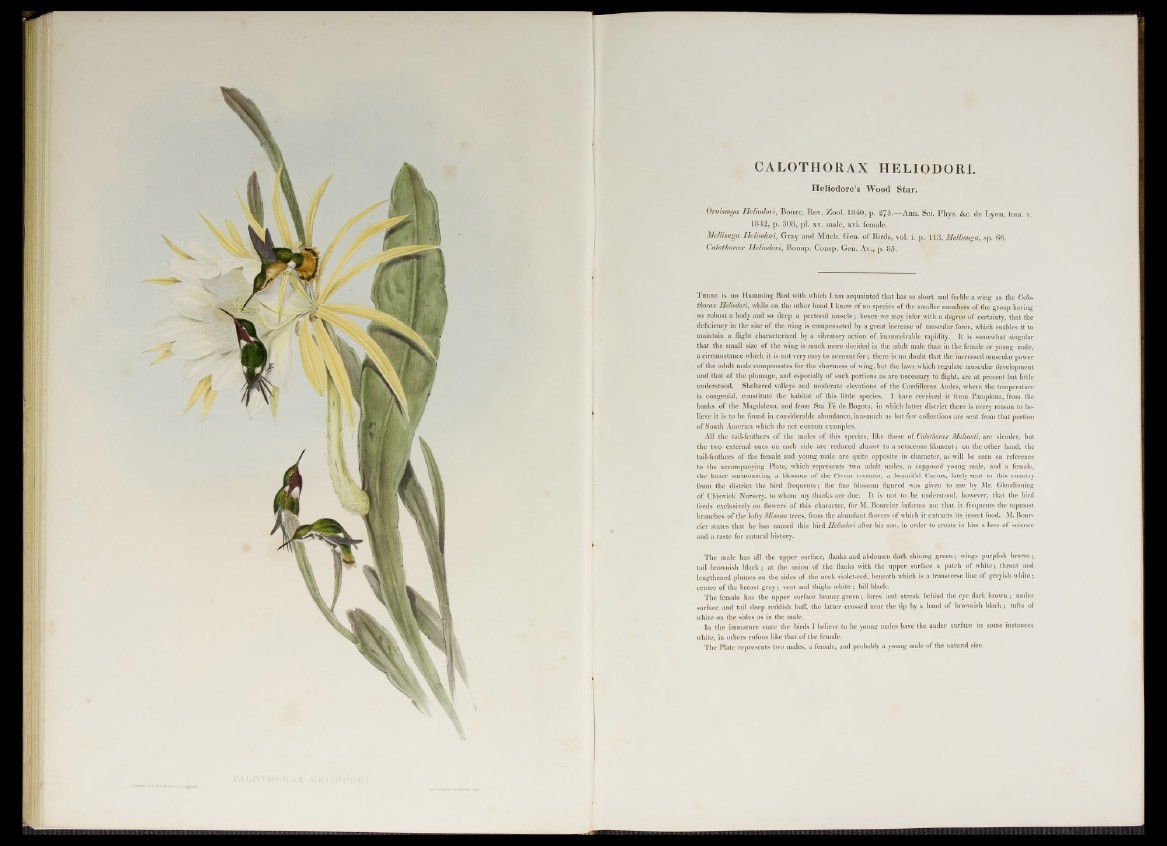
CALOTHORAX HELIODORI.
Heliodore’s Wood Star.
Ornismya Heliodori, Bourc. Rev. Zool. 1840, p. 275M-Ann. Sci. Phys. &c. de Lyon, tom. v.
1842, p. 308, pi. xv. male, xvi. female.
Mellisuga Heliodori, Gray and Mitch. Gen. of Birds, vol. i. p. 113, Mellisuga, sp. 66.
Calothorax Heliodori, Bonap. Consp. Gen. Av., p. 85.
T here is no Humming Bird with which I am acquainted that has so short and feeble a wing as the Calothorax
Heliodori, while on the other hand I know of no species of the smaller members of the group having
so robust a body and so deep a pectoral muscle; hence we may infer with a degree of certainty, that the
deficiency in the size of the wing is compensated by a great increase of muscular force, which enables it to
maintain a flight characterized by a vibratory action of inconceivable rapidity. It is somewhat singular
that the small size of the wing is much more decided in the adult male than in the female or young male,
a circumstance which it is not very easy to account for; there is no doubt that the increased muscular power
of the adult male compensates for the shortness of wing, but the laws which regulate muscular development
and that of the plumage, and especially of such portions as are necessary to flight, are at present but little
understood. Sheltered valleys and moderate elevations of the Cordilleran Andes, where the temperature
is congenial, constitute the habitat of this little species. I have received it from Pamplona, from the
banks of the Magdalena, and from Sta Fé de Bogota, in which latter district there is every reason to believe
it is to be found in considerable abundance, inasmuch as but few collections are sent from that portion
of South America which do not contain examples.
All the tail-feathers of the males of this species, like those of Calothorax Mulsanti, are slender, but
the two external ones on each side are reduced almost to a setaceous filament; on the other hand, the
tail-feathers of the female and young male are quite opposite in character, as will be seen on reference
to the accompanying Plate, which represents two adult males, a supposed young male, and a female,
the latter surmounting a blossom of the Cereus crenatus, a beautiful Cactus, lately sent to this country
from the district the bird frequents; the fine blossom figured was given to me by Mr. Glendinning
of Chiswick Nursery, to whom my thanks are due. It is not to be understood, however, that the bird
feeds exclusively on flowers of this character, for M. Bourcier informs me that it frequents the topmost
branches of the lofty Mimosa trees, from .the abundant flowers of which it extracts its insect food. M. Bourcier
states that he has named this bird Heliodori after his son, in order to create in him a love of science
and a taste for natural history.
The male has all the upper surface, flanks and abdomen dark shining green; wings purplish brown;
tail brownish black; at the union of the flanks with the upper surface a patch of white; throat and
lengthened plumes on the sides of the neck violet-red, beneath which is a transverse line of greyish white;
centre of the breast grey; vent and thighs white ; bill black.
The female has the upper surface bronzy green; lores and streak behind the eye dark brown; under
surface and tail deep reddish buff, the latter crossed near the tip by a band of brownish black; tufts of
white on the sides as in the male.
In the immature state the birds I believe to be young males have the under surface in some instances
white, in others rufous like that of the female.
The Plate represents two males, a female, and probably a young male of the natural size.